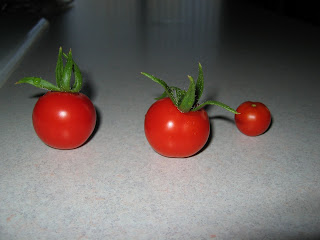The tomatoes are blossoming nicely. It is very exciting to see such progress with this new garden. My track record for keeping plants alive has been sporadic at best. With a little time, love, and proper care I am not doing to bad. Thank goodness for the Internet, with all the articles, forums, blogs, etc. I am learning a lot.
Now that the tomatoes were and still are blossoming, I was curious to whether I needed to get any Tomato Bloom Spray. Did some research and was getting conflicting points of view on the topic. So I decided... since I have six plants, lets experiment on half.
I purchased some Green Light Tomatoes Bloom Spray. It is supposed to promote flowering, increase blossom set, reduce blossom-end rot and increase the yield. The bottle states, that you can use it on other plants such as Beans, Cucumbers, Eggplants, Grapes, Melons Okra, Peppers (good deal), and Strawberries. Can’t guarantee any of it since I only have tomatoes and peppers.
So, I experimented on half of them and in two days I started to see results. (Then again it could have just been luck with a little dose of good timing).
On one half, I started to see some Fruit! I was simply astonished.

On the other half, I was experiencing some Blossom Drop. =( Oh no, what to do... and why is it happening? My first reaction was to use the Bloom Spray I used on the other three... then I thought no, lets find out WHY this is happening and see if there is any other way to fix the problem.
In doing some research on Blossom Dropping there are a few things I found that could cause this:
- Extreme weather conditions, too warm, too cold, too windy, can cause the blossoms to not set properly. (Okay, knowing that we had some extreme weather conditions one of the weekends that we were in Australia, windy with temps near 100 degrees. Ok, I will buy that.)
- Lack of Nitrogen or too much thereof. This happens if you fertilize too much, or not enough.
- Lack of Pollination. Now this was interesting... makes sense. So started thinking, I really haven’t seen a lot of bees around here lately. Not sure why that is but I then realized that I needed to plant some complimentary flowering plants near my tomatoes to attract insects that assist in the pollination process. Another way to assist in the pollination process is lightly shaking the tomato plants. I will just keep doing that until I get my Nasturtiums to grow and bloom. (So far.... this seems to be working)
- Insect damage
- Stress related to disease
- Lack of light
- Extended light exposures - (24 hour exposure to a light source)
- Excessive pruning
There are other factors I am certain, I recommend to do your research and see what best applies to you.
Until next log… Cheers!

















